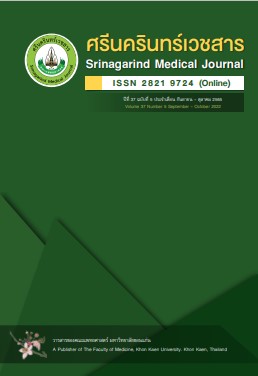Prunus Domestica L. Crude Extract Protects against Reductions of Memory in D-Galactose-Induced Aging in Adult Rat
Keywords:
memory, Prunus domestica L., D-galactose, agingAbstract
Background and Objective: A decline in memory is the most common pathology of aging. Brain degeneration during aging is related to upregulating the reactive oxygen species (ROS) levels, which induce oxidative stress, neuronal damage, and neuronal apoptosis. In animal studies, D-galactose caused down-regulation of neuronal circuitry and neurogenesis in the subgranular zone (SGZ) of the hippocampal dentate gyrus (DG) resulting in memory impairment. Prunus domestica L. (PD) or look-nai is a fruit that contains phenolic compounds and flavonoids. Previous studies have reported the beneficial effects of PD extract on learning and memory. Therefore, this study aimed to study the effect of PD extract on memory impairment in aging rats induced by D-gal.
Methods: Male Sprague Dawley rats were divided into 8 groups: Vehicle, D-gal, PD 75, PD 100, PD 150, D-gal + PD 75, D-gal + PD 100, and D-gal + PD 150. D-gal (50 mg/kg) and PD (75, 100 and 150 mg/kg) were given by intraperitoneal injection and digestive gavage once a day for 8 weeks, respectively. Rats was weighed during the experiment. Then, memory was tested using the novel object location (NOL) and novel object recognition (NOR) tests.
Result: There were no statistically significant differences (p>0.05) in body weight and locomotor activity among the groups. For the NOL and NOR memory tests, the vehicle, PD 75, PD 100, PD 150, D-gal + PD 75, D-gal + PD 100, and D-gal + PD 150 groups were able to discriminate between the objects placed at the familiar and novel locations or the familiar and novel objects (p<0.05). On the other hand, the D-gal group was unable to distinguish in both tests.
Conclusion: This study demonstrates that PD (75, 100 and 150 mg/kg) had a beneficial effect to ameliorate D-gal-induced memory impairment.
References
McKhann GM, Knopman DS, Chertkow H, Hyman BT, Jack CR, Kawas CH, et al. The diagnosis of dementia due to Alzheimer’s disease: Recommendations from the National Institute on Aging-Alzheimer’s Association workgroups on diagnostic guidelines for Alzheimer’s disease. Alzheimer’s Dement 2011;7(3):263–9.
Yassa MA, Lacy JW, Stark SM, Albert MS, Gallagher M, Stark CEL. Pattern separation deficits associated with increased hippocampal CA3 and dentate gyrus activity in nondemented older adults. Hippocampus 2011;21(9):968–79.
Ming G, Song H. Adult Neurogenesis in the Mammalian Brain: Significant Answers and Significant Questions. Neuron 2011;70(4):687–702.
Acosta PB, Gross KC. Hidden sources of galactose in the environment. Eur J Pediatr 1995;154(7 Suppl 2):87-92.
Hong XP, Chen T, Yin NN, Han YM, Yuan F, Duan YJ, et al. Puerarin Ameliorates D-Galactose Induced Enhanced Hippocampal Neurogenesis and Tau Hyperphosphorylation in Rat Brain. J Alzheimer’s Dis 2016;51(2):605–17.
Cannizzo ES, Clement CC, Sahu R, Follo C, Santambrogio L. Oxidative stress, inflamm-aging and immunosenescence. J Proteomics 2011;74(11):2313-23.
Prajit R, Sritawan N, Suwannakot K, Naewla S, Aranarochana A, Sirichoat A, et al. Chrysin protects against memory and hippocampal neurogenesis depletion in D-galactose-induced aging in rats. Nutrients 2020;12(4):1100.
Egbekun MK, Akowe JI, Ede RJ. Physico-chemical and sensory properties of formulated syrup from black plum (Vitex doniana) fruit. Plant Foods Hum Nutr 1996;49(4):301-6.
Bouayed J, Rammal H, Dicko A, Younos C, Soulimani R. Chlorogenic acid, a polyphenol from Prunus domestica (Mirabelle), with coupled anxiolytic and antioxidant effects. J Neurol Sci 2007;262(1-2):77-84.
Kayano SI, Kikuzaki H, Fukutsuka N, Mitani T, Nakatani N. Antioxidant activity of prune (Prunus domestica L.) constituents and a new synergist. J Agric Food Chem 2002;50(13):3708–12.
Fardell JE, Vardy J, Shah JD, Johnston IN. Cognitive impairments caused by oxaliplatin and 5-fluorouracil chemotherapy are ameliorated by physical activity. Psychopharmacology (Berl) 2012;220(1):183–93.
Sirichoat A, Chaijaroonkhanarak W, Prachaney P, Pannangrong W, Leksomboon R, Chaichun A, et al. Effects of Asiatic acid on spatial working memory and cell proliferation in the adult rat hippocampus. Nutrients 2015;7(10):8413–23.
Chaisawang P, Sirichoat A, Chaijaroonkhanarak W, Pannangrong W, Sripanidkulchai B, Wigmore P, et al. Asiatic acid protects against cognitive deficits and reductions in cell proliferation and survival in the rat hippocampus caused by 5-fluorouracil chemotherapy. PLoS One 2017;12(7):1–14.
Shahidi S, Setareye S, Mahmoodi M. Effect of Prunus domestica L. (mirabelle) on learning and memory in mice. Anc Sci Life 2013;32(3):139-43.
Kumar A, Prakash A, Dogra S. Centella asiatica Attenuates D-Galactose-Induced Cognitive Impairment, Oxidative and Mitochondrial Dysfunction in Mice. Int J Alzheimers Dis 2011;2011:1-9.
Ullah H, Sommella E, Santarcangelo C, D'Avino D, Rossi A, Dacrema M, et al. Hydroethanolic Extract of Prunus domestica L.: Metabolite Profiling and In Vitro Modulation of Molecular Mechanisms Associated to Cardiometabolic Diseases. Nutrients 2022;14(2):340.
Hsieh HM, Wu WM, Hu ML. Soy isoflavones attenuate oxidative stress and improve parameters related to aging and Alzheimer’s disease in C57BL/6J mice treated with d-galactose. Food Chem Toxicol 2009;47(3):625–32.
Nam S, Seo M, Seo J, Rhim H, Nahm S, Cho I et al. Ascorbic Acid Mitigates D-galactose-Induced Brain Aging by Increasing Hippocampal Neurogenesis and Improving Memory Function. Nutrients 2019;11(1):176.
Akirav I, Maroun M. Ventromedial prefrontal cortex is obligatory for consolidation and reconsolidation of object recognition memory. Cereb Cortex 2006;16(12):1759-65.
Murai T, Okuda S, Tanaka T, Ohta H. Characteristics of object location memory in mice: Behavioral and pharmacological studies. Physiol Behav 2007;90(1):116-24.
Roser M, Josic D, Kontou M, Mosetter K, Maurer P, Reutter W. Metabolism of galactose in the brain and liver of rats and its conversion into glutamate and other amino acids. J Neural Transm 2009;116(2):131–9.
Tomás-Barberán FA, Gil MI, Cremin P, Waterhouse AL, Hess-Pierce B, Kader AA. HPLC-DAD-ESIMS analysis of phenolic compounds in nectarines, peaches, and plums. J Agric Food Chem 2001;49(10):4748-60.
Spencer JP. Food for thought: the role of dietary flavonoids in enhancing human memory, learning and neuro-cognitive performance. Proc Nutr Soc 2008;67(2):238-52.
Downloads
Published
How to Cite
Issue
Section
License
Copyright (c) 2022 Srinagarind Medical Journal

This work is licensed under a Creative Commons Attribution-NonCommercial-NoDerivatives 4.0 International License.




